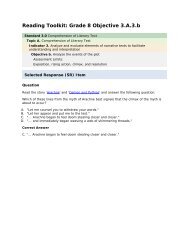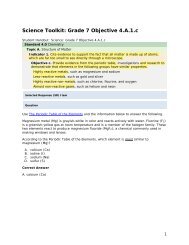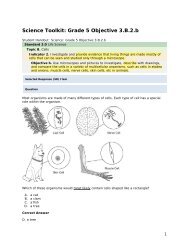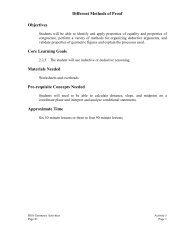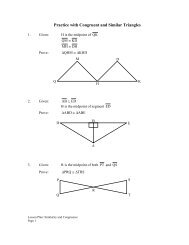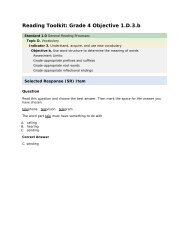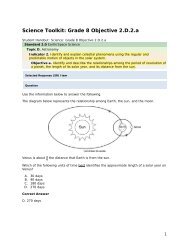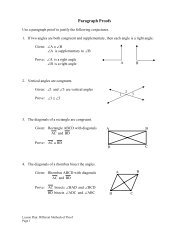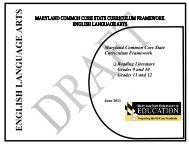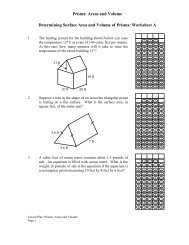Quadrilaterals in the Coordinate Plane - mdk12
Quadrilaterals in the Coordinate Plane - mdk12
Quadrilaterals in the Coordinate Plane - mdk12
You also want an ePaper? Increase the reach of your titles
YUMPU automatically turns print PDFs into web optimized ePapers that Google loves.
<strong>Quadrilaterals</strong> <strong>in</strong> <strong>the</strong> Coord<strong>in</strong>ate <strong>Plane</strong><br />
1. Given: A (4, 3), B (8, 3), C (9, 10), and D (5, 10) are vertices of a quadrilateral. Is<br />
quadrilateral ABCD a parallelogram? Use ma<strong>the</strong>matics to justify your answer.<br />
(graph<strong>in</strong>g is not acceptable).<br />
2. Verify ABCD is a parallelogram by choos<strong>in</strong>g one pair of opposite sides and show<strong>in</strong>g<br />
<strong>the</strong>m parallel and congruent. Use ma<strong>the</strong>matics to expla<strong>in</strong> how you determ<strong>in</strong>ed your<br />
answer. Use words, symbols, or both <strong>in</strong> your explanation<br />
Alternate assignment<br />
3. If A(2, 1), B(5, 4), C(8, 12), and D(5, 9) are <strong>the</strong> vertices of a quadrilateral, verify that<br />
quadrilateral ABCD is a parallelogram. Use ma<strong>the</strong>matics to justify your answer. (Do<br />
<strong>the</strong> problem 4 different ways.)<br />
1. Both pairs of opposite sides parallel.<br />
2. Both pairs of opposite sides congruent.<br />
3. One pair of sides congruent and parallel.<br />
4. Diagonals bisect each o<strong>the</strong>r.<br />
Lesson Plan: Application of Properties of <strong>Quadrilaterals</strong> <strong>in</strong> <strong>the</strong> Coord<strong>in</strong>ate <strong>Plane</strong><br />
Page 1
Method 1: Let's show that this is a parallelogram us<strong>in</strong>g <strong>the</strong> def<strong>in</strong>ition of<br />
parallelogram. Ask: So what do we need to show? Both pairs of opposite<br />
sides are parallel. We might be able to see this better if we make a rough<br />
sketch so we know which sides we are talk<strong>in</strong>g about. After mak<strong>in</strong>g <strong>the</strong> sketch<br />
of ABCD (this may be a rough sketch with no orientation to <strong>the</strong> given<br />
coord<strong>in</strong>ates), have students decide which pairs of sides need to be parallel.<br />
Then have <strong>the</strong>m f<strong>in</strong>d <strong>the</strong> slopes. (You can save time by divid<strong>in</strong>g up <strong>the</strong> labor.)<br />
After comput<strong>in</strong>g <strong>the</strong> slopes, <strong>the</strong>y should f<strong>in</strong>d that <strong>the</strong> slope of AB and DC is<br />
0, and <strong>the</strong> slope of BC and AD is 7.<br />
Justification of method one: Now that we have <strong>the</strong> slopes computed we need to<br />
write a sentence or two expla<strong>in</strong><strong>in</strong>g what we did and why we did it. I used <strong>the</strong><br />
slope formula to f<strong>in</strong>d <strong>the</strong> slopes of <strong>the</strong> sides of <strong>the</strong> quadrilateral. The slope of<br />
AB = BC = 0 and <strong>the</strong> slope of BC = AD = 7. Both pairs of opposite sides<br />
have <strong>the</strong> same slope so I know that <strong>the</strong>se sides are parallel. Therefore ABCD<br />
is a parallelogram by def<strong>in</strong>ition: a parallelogram is a quadrilateral with two<br />
pairs of parallel sides.<br />
Method 2: What is ano<strong>the</strong>r way to prove that ABCD is a parallelogram? One<br />
of your students will respond: Both pairs of opposite sides are congruent.<br />
Then: Which sides would we want to get congruent? (Same sides that we used<br />
before.) Which formula will we use this time? (distance formula). So, we<br />
need to show? (AB DC and BC= D). Have <strong>the</strong> students apply <strong>the</strong> distance<br />
formula. To save time, assign different groups <strong>the</strong> different lengths. After<br />
comput<strong>in</strong>g <strong>the</strong> lengths, <strong>the</strong>y should have found that AB = DC = 4 and BC =<br />
AD = square root of 50, or approx. 7.07. Have <strong>the</strong> groups write <strong>the</strong>ir<br />
justification. Let <strong>the</strong>m volunteer to share <strong>the</strong>ir work. Justification: by<br />
apply<strong>in</strong>g <strong>the</strong> distance formula I found two pairs of congruent opposite sides:<br />
2 2<br />
AB = 0 + 4 = 4<br />
2 2<br />
DC= 0 + 4 = 4<br />
2 2<br />
AD= 7 + 1 = 50<br />
2 2<br />
BC= 7 + 1 = 50<br />
ABCD is a parallelogram by <strong>the</strong> <strong>the</strong>orem: If both pairs of opposite sides of a<br />
quadrilateral are congruent, <strong>the</strong>n <strong>the</strong> quadrilateral is a parallelogram.<br />
Lesson Plan: Application of Properties of <strong>Quadrilaterals</strong> <strong>in</strong> <strong>the</strong> Coord<strong>in</strong>ate <strong>Plane</strong><br />
Page 2
Answers to alternate assignment<br />
1. By us<strong>in</strong>g <strong>the</strong> slope formula, <strong>the</strong> slope of AB and CD is 1: <strong>the</strong> slope of AD<br />
and BC is 3<br />
8 . Because <strong>the</strong> slopes of <strong>the</strong>se pairs of sides are <strong>the</strong> same we can<br />
say ABCD is a parallelogram by def<strong>in</strong>ition: if both pairs of opposite sides are<br />
parallel <strong>the</strong>n <strong>the</strong> quadrilateral is a parallelogram.<br />
2. By us<strong>in</strong>g <strong>the</strong> distance formula, <strong>the</strong> length of AB and CD is 18 and <strong>the</strong><br />
length of AD and BC is 73 . S<strong>in</strong>ce both pairs of opposite sides are<br />
congruent we know ABCD is a parallelogram by <strong>the</strong> <strong>the</strong>orem: if both pairs of<br />
opposite sides are congruent <strong>the</strong>n <strong>the</strong> quadrilateral is a parallelogram.<br />
3. By us<strong>in</strong>g <strong>the</strong> slope formula, <strong>the</strong> slope of AB and CD is 1. The length of<br />
<strong>the</strong>se same sides is 18 . ABCD is a parallelogram by <strong>the</strong> <strong>the</strong>orem: if one<br />
pair of opposite sides is both parallel and congruent <strong>the</strong>n <strong>the</strong> quadrilateral is a<br />
parallelogram.<br />
4. By us<strong>in</strong>g <strong>the</strong> midpo<strong>in</strong>t formula, <strong>the</strong> midpo<strong>in</strong>ts of diagonals AC and BD are<br />
<strong>the</strong> same: (5,6.5). ABCD is a parallelogram by <strong>the</strong> <strong>the</strong>orem: if <strong>the</strong> diagonals<br />
bisect each o<strong>the</strong>r <strong>the</strong>n <strong>the</strong> quadrilateral is a parallelogram.<br />
Lesson Plan: Application of Properties of <strong>Quadrilaterals</strong> <strong>in</strong> <strong>the</strong> Coord<strong>in</strong>ate <strong>Plane</strong><br />
Page 3




